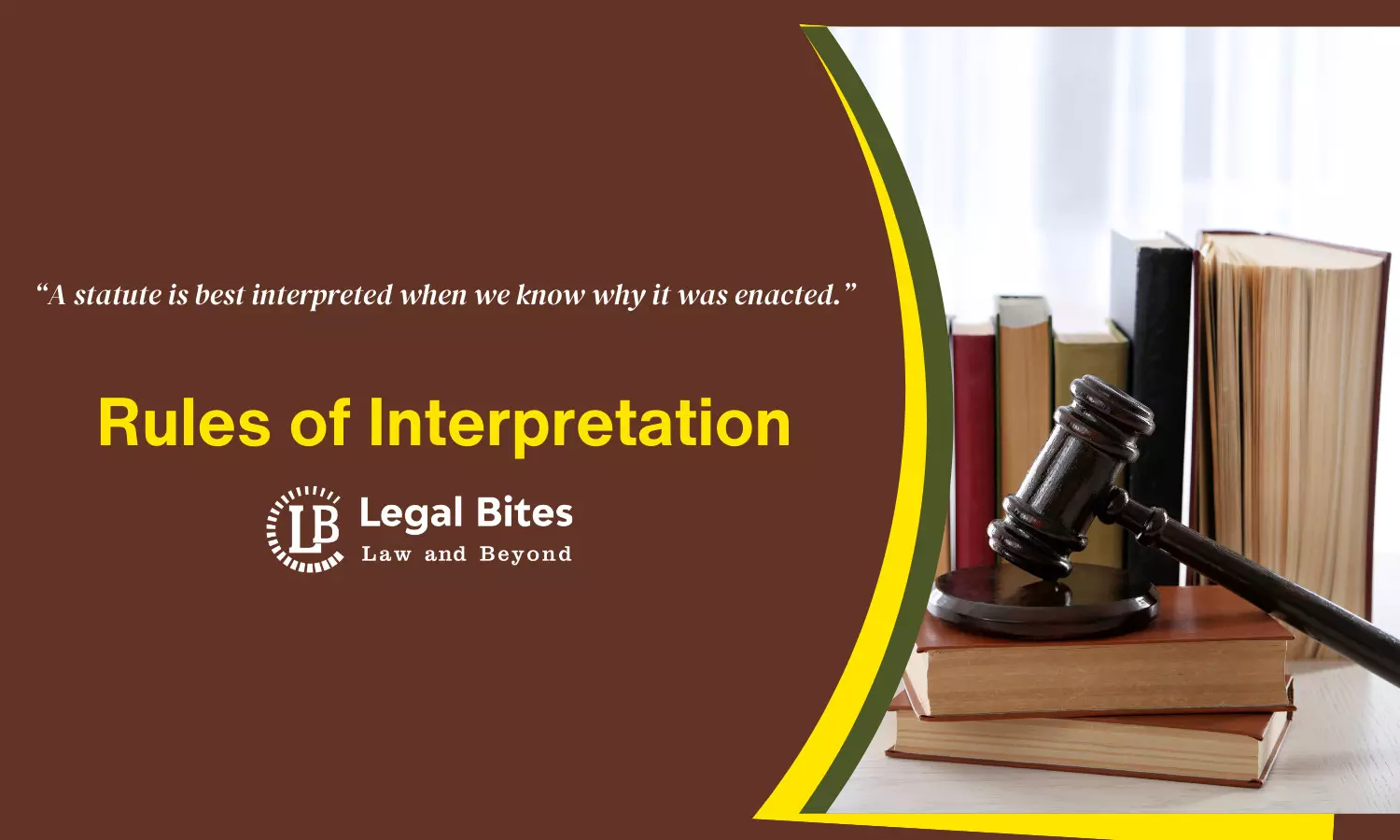Rules of Interpretation | Explained
In construing Statutes, the cardinal rule is to construe its provisions literally and grammatically, giving the words their ordinary and natural meaning.

Interpretation of statutes is a fundamental process in the legal system where courts attempt to ascertain the true meaning of legislative texts. Since laws are framed in language, and language is inherently ambiguous or open to multiple interpretations, the role of interpretation becomes crucial in ensuring that justice is delivered fairly and consistently. The process of interpretation involves understanding the intention of the legislature and applying it within the context of the case...
Interpretation of statutes is a fundamental process in the legal system where courts attempt to ascertain the true meaning of legislative texts. Since laws are framed in language, and language is inherently ambiguous or open to multiple interpretations, the role of interpretation becomes crucial in ensuring that justice is delivered fairly and consistently. The process of interpretation involves understanding the intention of the legislature and applying it within the context of the case at hand.
Courts rely on certain well-established rules of interpretation to resolve ambiguities and give effect to the purpose behind a statute. The major rules of statutory interpretation are:
- Literal Rule – Interpreting statutes based on the plain and natural meaning of the words used.
- Golden Rule – Modifying the literal meaning to avoid absurd results.
- Mischief Rule – Interpreting statutes based on the ‘mischief’ the statute was intended to remedy.
- Rule of Harmonious Construction – Resolving conflicts between two statutory provisions in a manner that gives effect to both.
This article provides a detailed examination of each of these rules, supported by relevant case laws and judicial principles.
1. Rule of Literal Interpretation
The Literal Rule of Interpretation is the primary and most fundamental rule of interpretation. According to this rule, the words of a statute should be given their ordinary, natural, and grammatical meaning unless such an interpretation leads to an absurdity or defeats the legislative intent. The underlying principle is that the intention of the legislature is best expressed through the plain meaning of the words used.
1.1 Rationale Behind the Literal Rule
The legislature is presumed to have chosen its words carefully.
The court’s role is not to legislate but to interpret.
Giving words their ordinary meaning ensures consistency and predictability in the law.
1.2 Key Case Laws on the Literal Rule
In R v. Judge of the City of London Court (1892), the court held that:
"If the words of an Act are clear, you must follow them, even though they lead to a manifest absurdity. The court has nothing to do with the question whether the legislature has committed an absurdity."
In State of Kerala v. Mathai Verghese (1987), the court ruled that when the language of the statute is clear and unambiguous, the courts have to give effect to it, irrespective of its consequences.
In CIT v. Keshav Lal (1965), the Supreme Court held that it is not open to the courts to discard the plain meaning of the words used in the statute and adopt a different construction.
1.3 Limitations of the Literal Rule
This can lead to unjust or unintended outcomes if the language of the statute is defective.
- May not reflect the true intent of the legislature in complex or technical cases.
- Sometimes results in absurd or impractical interpretations.
2. Golden Rule of Interpretation
The Golden Rule is an exception to the Literal Rule. When the application of the literal meaning of the words in a statute leads to an absurdity or inconsistency, the golden rule allows the courts to depart from the literal meaning and adopt a more reasonable interpretation that avoids such an outcome.
2.1 Principle Behind the Golden Rule
- The golden rule modifies the literal meaning only to the extent necessary to avoid an absurd or unjust result.
- It balances the need for literal interpretation with the need to give effect to the legislative intent.
2.2 Types of Application
Narrow Application – Courts modify the ordinary meaning of a word or phrase to prevent absurdity.
Broad Application – Courts adopt an alternative meaning of a word to avoid an outcome that is inconsistent with legislative intent.
2.3 Key Case Laws on the Golden Rule
In Grey v. Pearson (1857), The court held that:
"The grammatical and ordinary sense of the words is to be adhered to, unless that would lead to some absurdity or some repugnance or inconsistency with the rest of the instrument."
In Lee v. Knapp (1967), The Road Traffic Act required a driver to ‘stop’ after an accident. The driver stopped for a moment and then drove away. The court held that ‘stop’ must mean stopping for a reasonable period, not just momentarily.
In Tirath Singh v. Bachittar Singh (1955), The Supreme Court of India ruled that where the literal interpretation of a statute leads to an absurd result, the golden rule can be applied to avoid such an outcome.
2.4 Limitations of the Golden Rule
- Courts have limited discretion under the golden rule.
- Cannot be applied where the language of the statute is clear and unambiguous.
- Can result in judicial law-making if overused.
3. Mischief Rule (Heydon's Rule)
The Mischief Rule is based on the judgment in Heydon's Case (1584). According to this rule, the court must interpret a statute in such a way that it suppresses the mischief the statute was intended to remedy and advances the remedy.
3.1 Principle Behind the Mischief Rule
The court, while applying the mischief rule, must consider four factors:
- What was the law before the statute was passed?
- What was the mischief or defect in that law?
- What remedy did the statute provide to address the mischief?
- What is the true reason for the remedy?
3.2 Key Case Laws on the Mischief Rule
In Heydon’s Case (1584), the court established that:
"The office of the judge is to always make such construction as shall suppress the mischief and advance the remedy."
In Smith v. Hughes (1960), Prostitutes were soliciting men from balconies and windows. The court held that the law prohibiting solicitation ‘in the street’ was meant to prevent the mischief of harassment, so the soliciting from windows was held to be within the statute's scope.
In Bengal Immunity Co. v. State of Bihar (1955), the Supreme Court of India applied the mischief rule to hold that the intent of the statute was to prevent multiple state taxes on the same goods.
3.3 Limitations of the Mischief Rule
- Over-reliance on legislative intent can lead to subjective interpretations.
- Courts may exceed their authority by filling gaps in legislation.
- The mischief rule may not work well for modern, complex legislation.
4. Rule of Harmonious Construction
The Rule of Harmonious Construction is applied when there is an apparent conflict between two or more provisions of the same statute. According to this rule, the provisions should be interpreted in a manner that reconciles them and gives effect to both, rather than rendering one provision redundant.
4.1 Principle Behind Harmonious Construction
- Every part of the statute should be given effect.
- Courts should avoid interpretations that render any provision meaningless or redundant.
- Courts should attempt to give a consistent and coherent meaning to the entire statute.
4.2 Key Case Laws on Harmonious Construction
In CIT v. Hindustan Bulk Carriers (2003), the Supreme Court held that:
"When two provisions of a statute conflict with each other, they should be interpreted in such a way that both are given effect, without destroying the essence of either."
In Union of India v. Brigadier P.S. Gill (2012), the court held that the provisions of a statute should be construed harmoniously to avoid any conflict.
In State of Rajasthan v. Gopi Kishan Sen (1995), the court resolved a conflict between two provisions related to land acquisition, holding that both provisions should be read together to avoid contradictions.
4.3 Limitations of Harmonious Construction
- May not work where two provisions are inherently contradictory.
- Courts have limited scope for rewriting statutes.
- Some conflicts cannot be harmonized without undermining legislative intent.
Conclusion
Statutory interpretation is one of the core functions of the judiciary. The rules of interpretation – literal, golden, mischief, and harmonious construction – provide guiding principles for courts to ascertain legislative intent and ensure that statutes are applied fairly and consistently. While the literal rule remains the primary rule of interpretation, the golden rule, mischief rule, and harmonious construction serve as corrective mechanisms to prevent unjust or absurd outcomes. Judicial interpretation of statutes reflects a balance between the literal meaning of words and the broader legislative intent.

Mayank Shekhar
Mayank is an alumnus of the prestigious Faculty of Law, Delhi University. Under his leadership, Legal Bites has been researching and developing resources through blogging, educational resources, competitions, and seminars.
